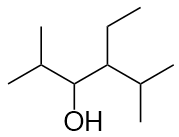Chapter 10. Organic Chemistry
10.4 Nomenclature of Alcohols and Ethers
Learning Objectives
- Describe the structure and properties of alcohols
- Describe the structure and properties of ethers
- Name and draw structures for alcohols and ethers
Naming Alcohols
The name of an alcohol comes from the hydrocarbon from which it was derived. The final -e in the name of the hydrocarbon is replaced by -ol, and the carbon atom to which the hydroxyl group (OH group) is bonded is indicated by a number placed before the name.[1]
Therefore when naming alcohols following IUPAC, you follow the similar two rules for alkanes with modification to “rule 1” mentioned above.
Rule 1. Identify the longest chain of carbons which contains the OH group and its position (PREFIX-#-ANE+OL). And when numbering the parent chain, the hydroxyl group gets the lowest possible number.
Rule 2. Names and position of the substituents.
Alcohols containing two or more hydroxyl groups can be made. Examples include 1,2-ethanediol (ethylene glycol, used in antifreeze) and 1,2,3-propanetriol (glycerine, used as a solvent for cosmetics and medicines):
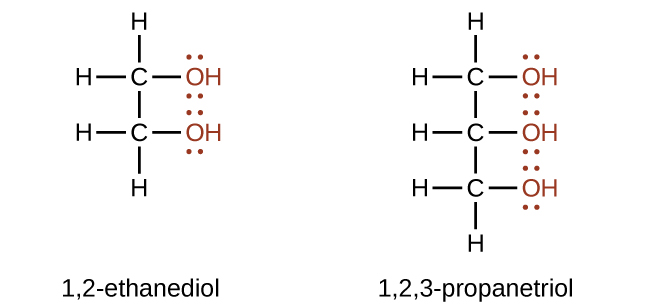
Example 1
Consider the following example. How should it be named?

Solution
The carbon chain contains five carbon atoms. If the hydroxyl group was not present, we would have named this molecule pentane. To address the fact that the hydroxyl group is present, we change the ending of the name to -ol. In this case, since the –OH is attached to carbon 2 in the chain, we would name this molecule 2-pentanol.
Test Yourself
Name the following molecule:
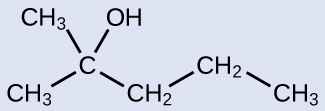
Answer
2-methylpentan-2-ol
Naming Ethers
Ethers are compounds that contain the functional group –O–. Ethers do not have a designated suffix like the other types of molecules we have named so far. In the IUPAC system, the oxygen atom and the smaller carbon branch are named as an alkoxy substituent and the remainder of the molecule as the base chain, as in alkanes. As shown in the following compound, the red symbols represent the smaller alkyl group and the oxygen atom, which would be named “methoxy.” The larger carbon branch would be ethane, making the molecule methoxyethane. Many ethers are referred to with common names instead of the IUPAC system names. For common names, the two branches connected to the oxygen atom are named separately and followed by “ether.” But if the two alkyl groups are the same, then the di prefix is used. The common name for methoxyethane shown below is ethylmethyl ether:

Therefore when naming ethers, the two rules are modified. And furthermore, there are two ways that are commonly used: IUPAC method and the common method.
IUPAC method of naming ethers:
Rule 1. Identify the longest carbon branch (PREFIX-ANE).
Rule 2. Names of the substituent, the other carbon branch (PREFIX+OXY)
Common method of naming ethers:
ALKYLALKYL ether or diALKYL ether
For example, the following ether would be commonly named ethylpropyl ether. its name following the IUPAC rules would be ethoxypropane.

Example 2
Provide the IUPAC and common name for the ether shown here:

Solution
IUPAC: The molecule is made up of an ethoxy group attached to an ethane chain, so the IUPAC name would be ethoxyethane.
Common: The groups attached to the oxygen atom are both ethyl groups, so the common name would be diethyl ether.
Test Yourself
Provide the IUPAC and common name for the ether shown:
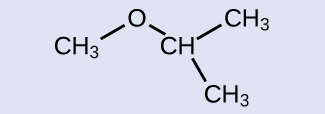
Answers
IUPAC: 2-methoxypropane; common: isopropylmethyl ether

Want more practice naming ethers? This brief video review summarizes the nomenclature for ethers.
Carbohydrates and Diabetes
Carbohydrates are large biomolecules made up of carbon, hydrogen, and oxygen. The dietary forms of carbohydrates are foods rich in these types of molecules, like pastas, bread, and candy. The name “carbohydrate” comes from the formula of the molecules, which can be described by the general formula Cm(H2O)n, which shows that they are in a sense “carbon and water” or “hydrates of carbon.” In many cases, m and n have the same value, but they can be different. The smaller carbohydrates are generally referred to as “sugars,” the biochemical term for this group of molecules is “saccharide” from the Greek word for sugar (Figure 1). Depending on the number of sugar units joined together, they may be classified as monosaccharides (one sugar unit), disaccharides (two sugar units), oligosaccharides (a few sugars), or polysaccharides (the polymeric version of sugars—polymers were described in the feature box earlier in this chapter on recycling plastics). The scientific names of sugars can be recognized by the suffix -ose at the end of the name (for instance, fruit sugar is a monosaccharide called “fructose” and milk sugar is a disaccharide called lactose composed of two monosaccharides, glucose and galactose, connected together). Sugars contain some of the functional groups we have discussed: Note the alcohol groups present in the structures and how monosaccharide units are linked to form a disaccharide by formation of an ether.
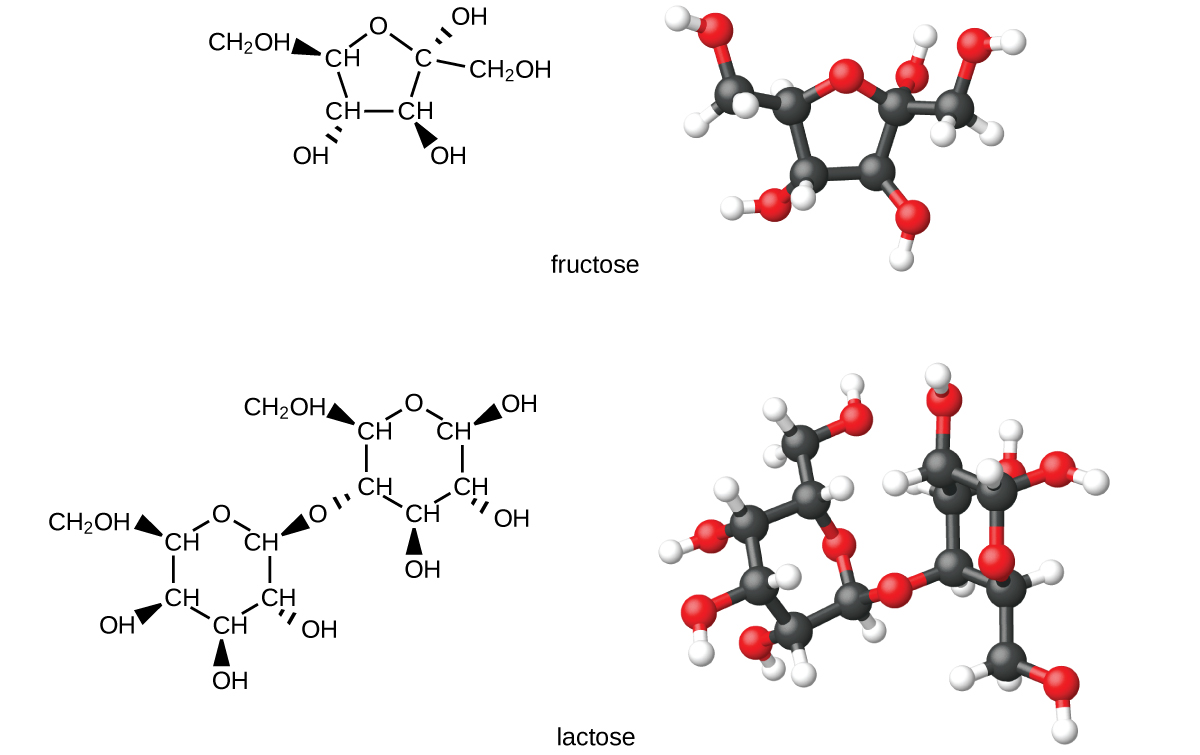
Organisms use carbohydrates for a variety of functions. Carbohydrates can store energy, such as the polysaccharides glycogen in animals or starch in plants. They also provide structural support, such as the polysaccharide cellulose in plants and the modified polysaccharide chitin in fungi and animals. The sugars ribose and deoxyribose are components of the backbones of RNA and DNA, respectively. Other sugars play key roles in the function of the immune system, in cell-cell recognition, and in many other biological roles.
Diabetes is a group of metabolic diseases in which a person has a high sugar concentration in their blood (Figure 2). Diabetes may be caused by insufficient insulin production by the pancreas or by the body’s cells not responding properly to the insulin that is produced. In a healthy person, insulin is produced when it is needed and functions to transport glucose from the blood into the cells where it can be used for energy. The long-term complications of diabetes can include loss of eyesight, heart disease, and kidney failure.
In 2013, it was estimated that approximately 3.3% of the world’s population (~380 million people) suffered from diabetes, resulting in over a million deaths annually. Prevention involves eating a healthy diet, getting plenty of exercise, and maintaining a normal body weight. Treatment involves all of these lifestyle practices and may require injections of insulin.
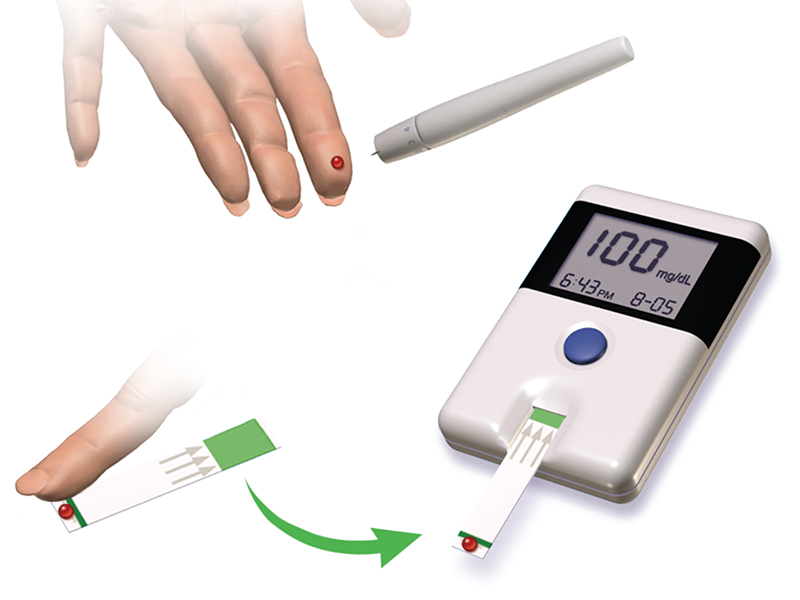
Key Concepts and Summary
Many organic compounds that are not hydrocarbons can be thought of as derivatives of hydrocarbons. A hydrocarbon derivative can be formed by replacing one or more hydrogen atoms of a hydrocarbon by a functional group, which contains at least one atom of an element other than carbon or hydrogen. The properties of hydrocarbon derivatives are determined largely by the functional group. The –OH group is the functional group of an alcohol. The –R–O–R– group is the functional group of an ether.
The systematic methods of naming alcohols follow a similar procedure and the names have three main parts:
1) specifying the information about the substituents,
2) specifying the information about the parent chain, and
3) the ending which specifies what functional group is present in the structure being named.
Alcohols: #-substituents–PREFIX–#-ANE+OL
Ethers: PREFIX+OXY–PREFIX–ANE
Remember: there are two ways that are commonly used to name ethers. The common method is also important to know.
Common method of naming ethers:
ALKYLALKYL ether or diALKYL ether
Exercises
1. Write condensed formulas and provide IUPAC names for the following compounds:
a) ethyl alcohol (in beverages)
b) methyl alcohol (used as a solvent, for example, in shellac)
c) ethylene glycol (antifreeze)
d) isopropyl alcohol (used in rubbing alcohol)
e) glycerine
2. Give the complete IUPAC name for each of the following compounds:
a)
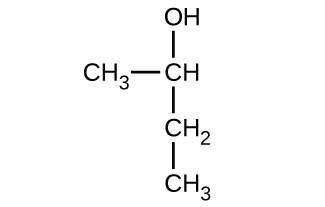
b)
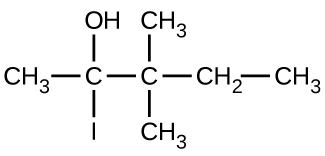
c)

3. Give the complete IUPAC name and the common name for each of the following compounds:
a)
![]()
b)

c)

4. Name this molecule.
Answers
1. a) ethyl alcohol, ethanol: CH3CH2OH; b) methyl alcohol, methanol: CH3OH; c) ethylene glycol, ethanediol: HOCH2CH2OH; d) isopropyl alcohol, 2-propanol: CH3CH(OH)CH3; e) glycerine, l,2,3-trihydroxypropane: HOCH2CH(OH)CH2OH
2. a) butan-2-ol; b) 2-iodo-3,3-dimethylpentan-2-ol; c) 3-chloro-3-ethylhexan-2-ol
3. a) 1-ethoxybutane, butyl ethyl ether; b) 1-ethoxypropane, ethyl propyl ether; c) 1-methoxypropane, methyl propyl ether
4. 3-chloropentan-3-ol
5. octan-4-ol
6. 4-ethyl-2,5-dimethylhexan-3-ol
Glossary
alcohol: organic compound with a hydroxyl group (–OH) bonded to a carbon atom
ether: organic compound with an oxygen atom that is bonded to two carbon atoms
- The IUPAC adopted new nomenclature guidelines in 2013 that require this number to be placed as an “infix” rather than a prefix. For example, the new name for 2-propanol would be propan-2-ol. Widespread adoption of this new nomenclature will take some time, and students are encouraged to be familiar with both the old and new naming protocols. ↵



